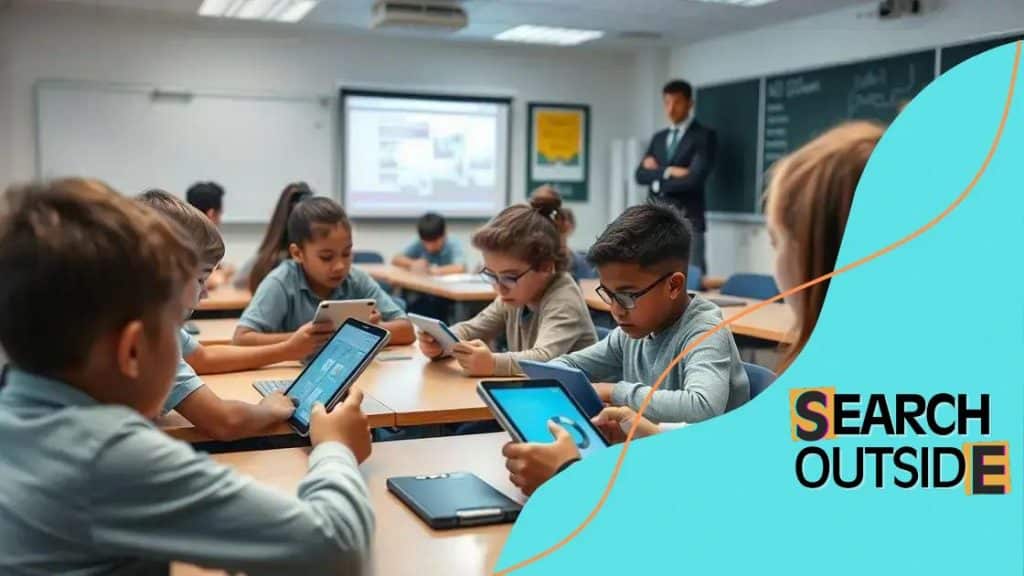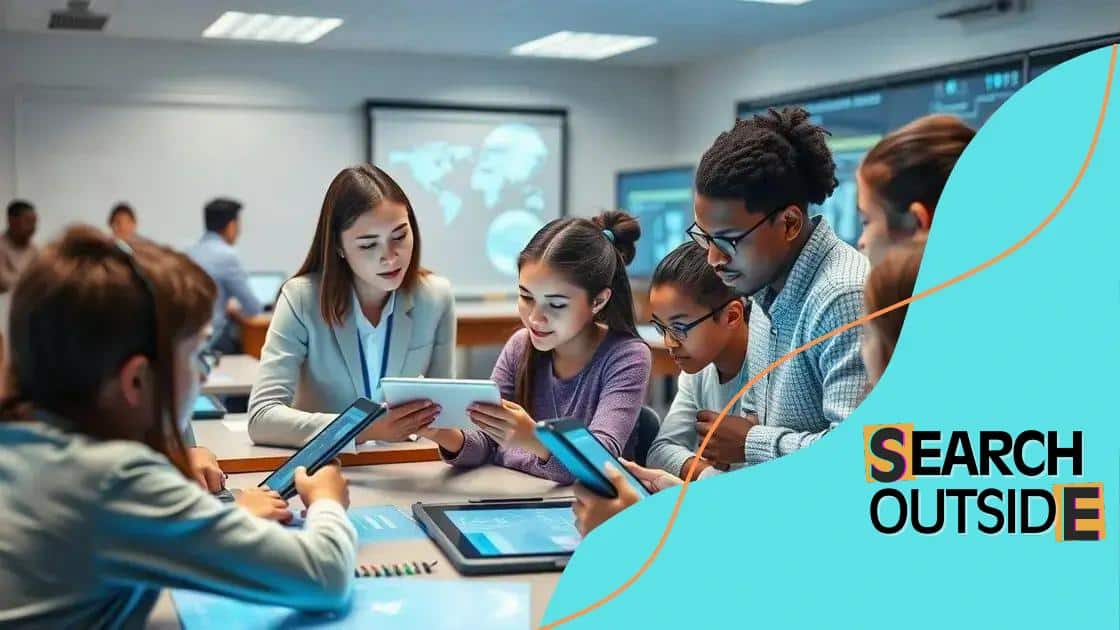The future of teaching and learning with AI in classrooms

Integrating AI in classrooms transforms the role of educators into facilitators who guide personalized learning, leveraging technology to enhance engagement while addressing challenges like technical issues and the need for ongoing training.
The future of teaching and learning with AI in classrooms is not just a distant dream; it’s unfolding right before our eyes. Imagine classrooms where personalized learning meets advanced technology, transforming the educational experience for everyone involved.
Understanding AI in education
Understanding AI in education is crucial as technology continues to transform classrooms. Educators today are increasingly integrating AI tools to enhance the teaching and learning process.
What is AI in Education?
AI, or artificial intelligence, refers to computer systems designed to perform tasks that typically require human intelligence. In education, this includes personalized learning experiences and automated assessments.
Benefits of AI in the Classroom
AI offers several benefits for both teachers and students:
- Personalization: AI can tailor learning materials to meet individual student needs.
- Efficiency: Automating administrative tasks allows teachers to focus more on instruction.
- Feedback: AI provides instant feedback to students, helping them improve their performance.
- Accessibility: AI tools can assist students with disabilities, ensuring everyone has equal access to learning opportunities.
Moreover, AI in education fosters a more engaging learning environment. This can lead to better retention of knowledge and enthusiasm for subjects among students. With interactive tools and smart technologies, students often feel more motivated to participate in their education.
As AI advances, its capabilities in education will grow. It’s essential for educators to stay informed about these developments to leverage them effectively. Understanding how AI can enhance their teaching styles may significantly impact student success.
Benefits of AI for teachers and students
The benefits of AI for teachers and students are expanding as technology integrates more deeply into education. With these advancements, both educators and learners experience enriched educational environments.
For Teachers
AI simplifies many tasks for teachers, providing assistance in planning and assessment. This allows educators to devote more time to teaching. With AI, teachers can effectively assess student performance using data-driven insights, making informed decisions about instructional strategies.
- Time Savings: Tasks like grading and scheduling can be automated, freeing up time for personalized student interaction.
- Resource Optimization: AI helps in creating tailored lesson plans that suit different learning styles.
- Professional Development: Through AI tools, teachers can access ongoing training and support tailored to their needs.
Moreover, AI can analyze classroom dynamics, allowing teachers to adjust their approaches based on how students respond.
For Students
Students equally benefit from AI in their learning journeys. With AI technologies, education becomes more engaging and tailored. Personalized learning paths help students master subjects at their own pace, which can lead to greater academic success.
- Individualized Learning: AI analyses each student’s strengths and weaknesses, adapting content accordingly.
- Instant Feedback: Students receive real-time assessments on their work, allowing them to see progress immediately.
- Expanded Resources: AI provides access to a broader range of educational materials, enabling deeper exploration of subjects.
This technology empowers students to take charge of their education by providing them with tools to learn more effectively. Ultimately, both teachers and students thrive in an environment enriched by AI, making learning more dynamic and impactful.
Implementing AI tools in classrooms

Implementing AI tools in classrooms can transform education, creating engaging and effective learning experiences. Schools around the world are recognizing the value of integrating these technologies into their teaching methods.
Choosing the Right AI Tools
Selecting appropriate AI tools is crucial for success. These tools should align with educational goals and meet the needs of both teachers and students. Educators can benefit from resources that streamline routines and enhance collaboration.
- Learning Management Systems: Platforms that utilize AI to customize learning paths make it easier for students to progress at their own pace.
- Grading Automation: AI can assist in automating grading processes, saving teachers valuable time.
- Virtual Tutors: These tools provide additional support for students who need extra help outside regular classroom hours.
Additionally, proper training is essential for both educators and students to fully utilize these tools. Professional development programs can equip teachers with the knowledge to implement AI effectively.
Creating a Supportive Environment
To successfully introduce AI tools, a supportive school culture is important. This includes fostering collaboration among teachers and encouraging student participation. Students should feel comfortable using technology and asking questions as they explore new learning methods. Encouraging experimentation with various tools enables students to discover what works best for them.
Moreover, constant feedback plays a significant role. Teachers can gather insights through AI analytics, allowing them to adjust their instruction based on student needs. This ensures learning remains relevant and engaging.
Overall, implementing AI tools in classrooms requires careful planning and support. By focusing on the right resources and cultivating a positive atmosphere, schools can maximize the benefits of AI in education.
Challenges of integrating AI in education
Integrating AI in education presents several challenges that schools must address to ensure successful implementation. As technology evolves, educators face obstacles that can hinder the effectiveness of AI tools.
Technical Issues
One significant challenge is the technical complexity of AI systems. Teachers and students may struggle to adapt to new technologies without proper support. Insufficient infrastructure can also limit successful implementation. Often, schools lack the necessary hardware or internet connectivity needed for AI tools to function.
- Training Needs: Educators require training to effectively utilize AI tools, which may not always be readily available.
- Cost Barriers: High costs associated with purchasing and maintaining AI technology can be a significant concern for many schools.
- Maintenance: Ongoing maintenance and updates are essential to keep AI systems operational and secure.
In addition to technical issues, another pressing concern is the concern over data privacy. Many AI tools collect data that may include sensitive information about students. Educators must ensure that these tools comply with privacy regulations and that students feel secure.
Resistance to Change
Resistance to change can also pose a barrier to integrating AI in education. Some educators may feel apprehensive about replacing traditional teaching methods with technology. This hesitation can stem from fear of the unknown or a lack of understanding of how AI can enhance learning. Addressing these concerns through clear communication about the benefits of AI and providing examples of successful implementations can help mitigate these fears.
Moreover, it’s crucial to have a supportive leadership team that encourages innovation. When school leaders advocate for AI integration, it fosters a culture of experimentation among teachers and students alike, allowing for growth and improvement.
Ultimately, while the challenges of integrating AI in education are significant, they are not insurmountable. With the right strategies, support, and resources, schools can create a dynamic learning environment that leverages AI technology effectively.
The role of educators in an AI-driven environment
The role of educators in an AI-driven environment is evolving and becoming more essential than ever. As technology becomes integrated into classrooms, teachers must adapt to new methods that enhance learning experiences for their students.
Facilitators of Learning
In an AI-infused classroom, educators serve as facilitators rather than just information providers. They guide students in using AI tools effectively and creatively. Teachers help students navigate complex technologies, encouraging critical thinking and problem-solving skills. Through this mentoring role, they ensure that students understand not just how to use tools but also when to use them.
- Encouraging Collaboration: Educators can foster teamwork by integrating AI tools that promote group work and peer feedback.
- Personalizing Education: Teachers can utilize AI insights to tailor lessons that meet individual student needs.
- Providing Emotional Support: In an increasingly tech-driven world, the human touch is irreplaceable. Educators offer guidance and support for students’ emotional and social development.
Additionally, teachers must engage with students on a level that promotes a love for learning. This can be achieved by creating an atmosphere where students feel safe to ask questions and explore new ideas.
Continuous Learning and Adaptation
As AI technology evolves, so too must educators. Continuous professional development is crucial. Teachers need ongoing training to stay current with the latest AI innovations and pedagogical techniques. This not only boosts their confidence but increases their effectiveness in the classroom.
Networking and collaborating with other educators can also enhance their learning opportunities. By sharing experiences, teachers gain new perspectives on how to implement AI tools successfully.
Ultimately, the role of educators goes beyond traditional teaching. In an AI-driven environment, they shape future generations by blending technology with essential human skills. They remain pivotal in guiding students to navigate this dynamic educational landscape.
In conclusion, the integration of AI in education is reshaping the roles of teachers and students alike. Educators must adapt to these changes, becoming guides who facilitate learning rather than solely providing information. While there are challenges, such as technical issues and resistance to change, the benefits greatly outweigh them. With proper training and a supportive environment, teachers can effectively harness the potential of AI to enhance educational experiences. It is crucial to focus on personalized learning, foster collaboration, and provide ongoing support, which will ultimately lead to successful outcomes for all students.
FAQ – Questions about the Role of Educators in an AI-Driven Environment
How can educators effectively use AI tools in the classroom?
Educators can use AI tools to personalize learning, provide instant feedback, and facilitate collaboration among students.
What challenges do teachers face when integrating AI in education?
Challenges include technical issues, the need for continuous training, and resistance to change from both faculty and students.
What support do educators need to succeed with AI?
Teachers need ongoing professional development and access to resources that help them understand and utilize AI technology effectively.
How does AI enhance the teaching experience?
AI enhances teaching by allowing educators to focus on individual student needs and fostering a more engaging and interactive learning environment.





